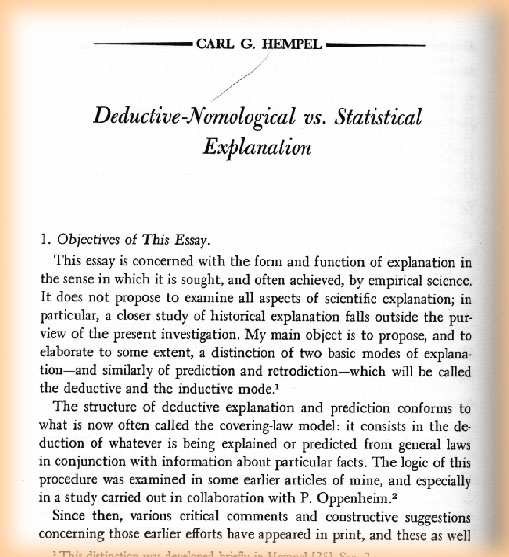![]()
Statistical Explanation
[科学的説明に関する論議について、Salmon (1990) の末尾に1989年までの年代順の文献表があるので大変参考になる。ここでは、統計的説明の分析が比較的新しいことを注意しておく。]
For the history of the discussion of scientific explanation in recent philosophy of science, Wes Salmon (1990) is the most definitive work. According to him, the models for statistical explanation appeared in 1962.
In an ariticle entitled "The Stochastic Revolution and the Nature of Scientific Explanation," Nicholas Rescher (1962) made an eloquent pleas for an extension of the concept of scientific explanation beyond the limits of deductive explanation. ...
The most important development to occur in the second decade (1958-1967) of our chronicle---the explicit treatment of statistical explanation---had its public inception in 1962. Although Rescher clearly recognized the inductive character of such explanations, neither he nor any of several other authors who recognized the legitimacy of statistical explanation offered an explicit model. ... Hempel appears to have been the first to notice the profound difficulties involved in statistical explanation, in particular, the problem of ambiguity, over which he labored long and hard. The first explicit model was offered in his "Deductive-Nomological vs. Statistical Explanation" (1962) in volume III of Minnesota Studies. ... In this paper, Hempel deals with statistical explanations of particular facts ... and characterizes what he later calls the inductive-statistical (I-S) Model. (Salmon 1990, 50-51)
[Hempel's 1962 Paper, the first page]

References
Hempel, C. G. (1962) "Deductive-Nomological vs. Statistical Explanation", Minnesota Studies in the Philosophy of Science, Vol. III, University of Minnesota Press, 1962.
Rescher, Nicholas (1962) "The Stochastic Revolution and the Nature of Scientific Explanation," Synthese 14, 1962.
Salmon, Wesley C. (1990) Four Decades of Scientific Explanation, University of Minnesota Press, 1990. [Originally in Minnesota Studies, Vol. XIII, 1989.]
Last modified June 14, 2005. (c) Soshichi Uchii